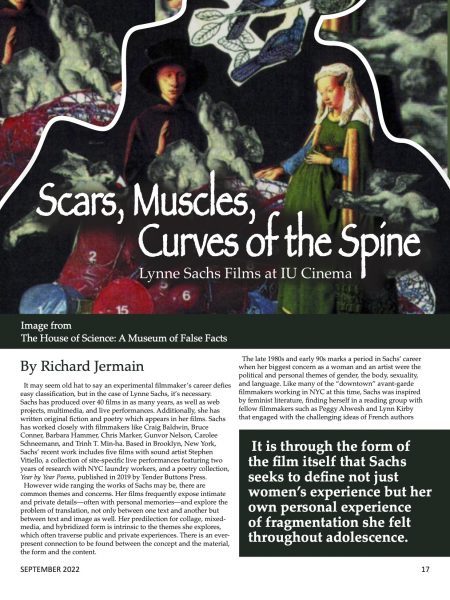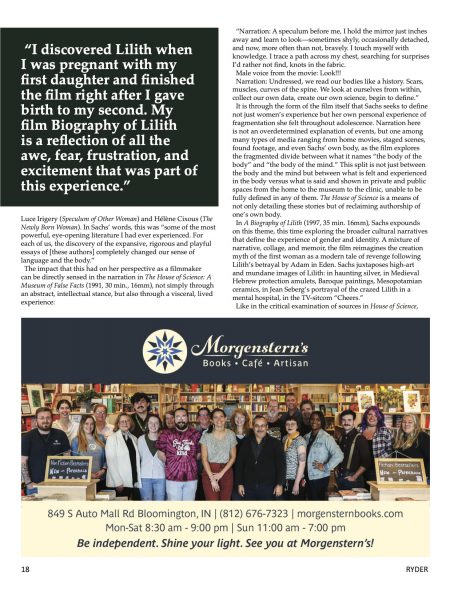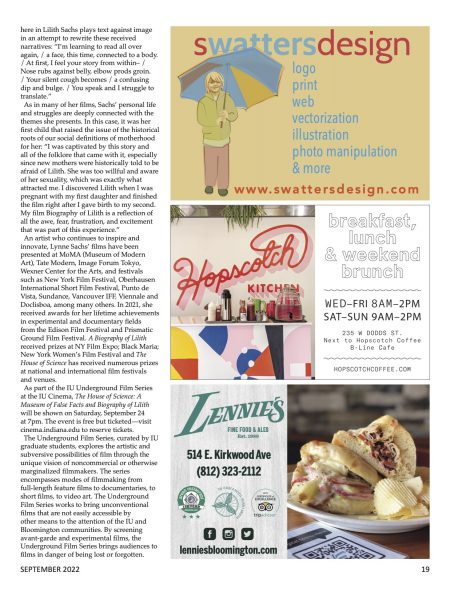
Scars, Muscles, Curves of the Spine: Lynne Sachs’ Films at IU Cinema
The Ryder Magazine
By Richard Jermain
September 1, 2022
https://online.flippingbook.com/view/986112840/16/
It may seem old hat to say an experimental filmmaker’s career defies easy classification, but in the case of Lynne Sachs, it’s necessary. Sachs has produced over 40 films in as many years, as well as web projects, multimedia, and live performances. Additionally, she has written original fiction and poetry which appears in her films. Sachs has worked closely with filmmakers like Craig Baldwin, Bruce Conner, Barbara Hammer, Chris Marker, Gunvor Nelson, Carolee Schneemann, and Trinh T. Min-ha. Based in Brooklyn, New York, Sachs’ recent work includes five films with sound artist Stephen Vitiello, a collection of site-specific live performances featuring two years of research with NYC laundry workers, and a poetry collection, Year by Year Poems, published in 2019 by Tender Buttons Press.
However wide ranging the works of Sachs may be, there are common themes and concerns. Her films frequently expose intimate and private details—often with personal memories—and explore the problem of translation, not only between one text and another but between text and image as well. Her predilection for collage, mixed- media, and hybridized form is intrinsic to the themes she explores, which often traverse public and private experiences. There is an ever- present connection to be found between the concept and the material, the form and the content.
The late 1980s and early 90s marks a period in Sachs’ career when her biggest concern as a woman and an artist were the political and personal themes of gender, the body, sexuality, and language. Like many of the “downtown” avant-garde filmmakers working in NYC at this time, Sachs was inspired by feminist literature, finding herself in a reading group with fellow filmmakers such as Peggy Ahwesh and Lynn Kirby that engaged with the challenging ideas of French authors
Luce Irigery (Speculum of Other Woman) and Hélène Cixous (The Newly Born Woman). In Sachs’ words, this was “some of the most powerful, eye-opening literature I had ever experienced. For each of us, the discovery of the expansive, rigorous and playful essays of [these authors] completely changed our sense of language and the body.”
The impact that this had on her perspective as a filmmaker can be directly sensed in the narration in The House of Science: A Museum of False Facts (1991, 30 min., 16mm), not simply through an abstract, intellectual stance, but also through a visceral, lived experience:
“Narration: A speculum before me, I hold the mirror just inches away and learn to look—sometimes shyly, occasionally detached, and now, more often than not, bravely. I touch myself with knowledge. I trace a path across my chest, searching for surprises I’d rather not find, knots in the fabric.
Male voice from the movie: Look!!!
Narration: Undressed, we read our bodies like a history. Scars, muscles, curves of the spine. We look at ourselves from within, collect our own data, create our own science, begin to define.”
It is through the form of the film itself that Sachs seeks to define not just women’s experience but her own personal experience of fragmentation she felt throughout adolescence. Narration here is not an overdetermined explanation of events, but one among many types of media ranging from home movies, staged scenes, found footage, and even Sachs’ own body, as the film explores the fragmented divide between what it names “the body of the body” and “the body of the mind.” This split is not just between the body and the mind but between what is felt and experienced in the body versus what is said and shown in private and public spaces from the home to the museum to the clinic, unable to be fully defined in any of them. The House of Science is a means of not only detailing these stories but of reclaiming authorship of one’s own body.
In A Biography of Lilith (1997, 35 min. 16mm), Sachs expounds on this theme, this time exploring the broader cultural narratives that define the experience of gender and identity. A mixture of narrative, collage, and memoir, the film reimagines the creation myth of the first woman as a modern tale of revenge following Lilith’s betrayal by Adam in Eden. Sachs juxtaposes high-art and mundane images of Lilith: in haunting silver, in Medieval Hebrew protection amulets, Baroque paintings, Mesopotamian ceramics, in Jean Seberg’s portrayal of the crazed Lilith in a mental hospital, in the TV-sitcom “Cheers.”
Like in the critical examination of sources in House of Science, here in Lilith Sachs plays text against image in an attempt to rewrite these received narratives: “I’m learning to read all over again, / a face, this time, connected to a body. / At first, I feel your story from within– / Nose rubs against belly, elbow prods groin. / Your silent cough becomes / a confusing dip and bulge. / You speak and I struggle to translate.”
As in many of her films, Sachs’ personal life and struggles are deeply connected with the themes she presents. In this case, it was her first child that raised the issue of the historical roots of our social definitions of motherhood for her: “I was captivated by this story and all of the folklore that came with it, especially since new mothers were historically told to be afraid of Lilith. She was too willful and aware of her sexuality, which was exactly what attracted me. I discovered Lilith when I was pregnant with my first daughter and finished the film right after I gave birth to my second. My film Biography of Lilith is a reflection of all the awe, fear, frustration, and excitement that was part of this experience.”
An artist who continues to inspire and innovate, Lynne Sachs’ films have been presented at MoMA (Museum of Modern Art), Tate Modern, Image Forum Tokyo, Wexner Center for the Arts, and festivals such as New York Film Festival, Oberhausen International Short Film Festival, Punto de Vista, Sundance, Vancouver IFF, Viennale and Doclisboa, among many others. In 2021, she received awards for her lifetime achievements in experimental and documentary fields from the Edison Film Festival and Prismatic Ground Film Festival. A Biography of Lilith received prizes at NY Film Expo; Black Maria; New York Women’s Film Festival and The House of Science has received numerous prizes at national and international film festivals and venues. As part of the IU Underground Film Series at the IU Cinema, The House of Science: A Museum of False Facts and Biography of Lilith will be shown on Saturday, September 24 at 7pm. The event is free but ticketed—visit cinema.indiana.edu to reserve tickets.
The Underground Film Series, curated by IU graduate students, explores the artistic and subversive possibilities of film through the unique vision of noncommercial or otherwise marginalized filmmakers. The series encompasses modes of filmmaking from full-length feature films to documentaries, to short films, to video art. The Underground Film Series works to bring unconventional films that are not easily accessible by other means to the attention of the IU and Bloomington communities. By screening avant-garde and experimental films, the Underground Film Series brings audiences to films in danger of being lost or forgotten.
Indiana University Cinema Underground Film Series
A Biography of Lilith and The House of Science: A Museum of False Facts
https://cinema.indiana.edu/upcoming-films/screening/2022-fall-program-saturday-september-24-700pm



